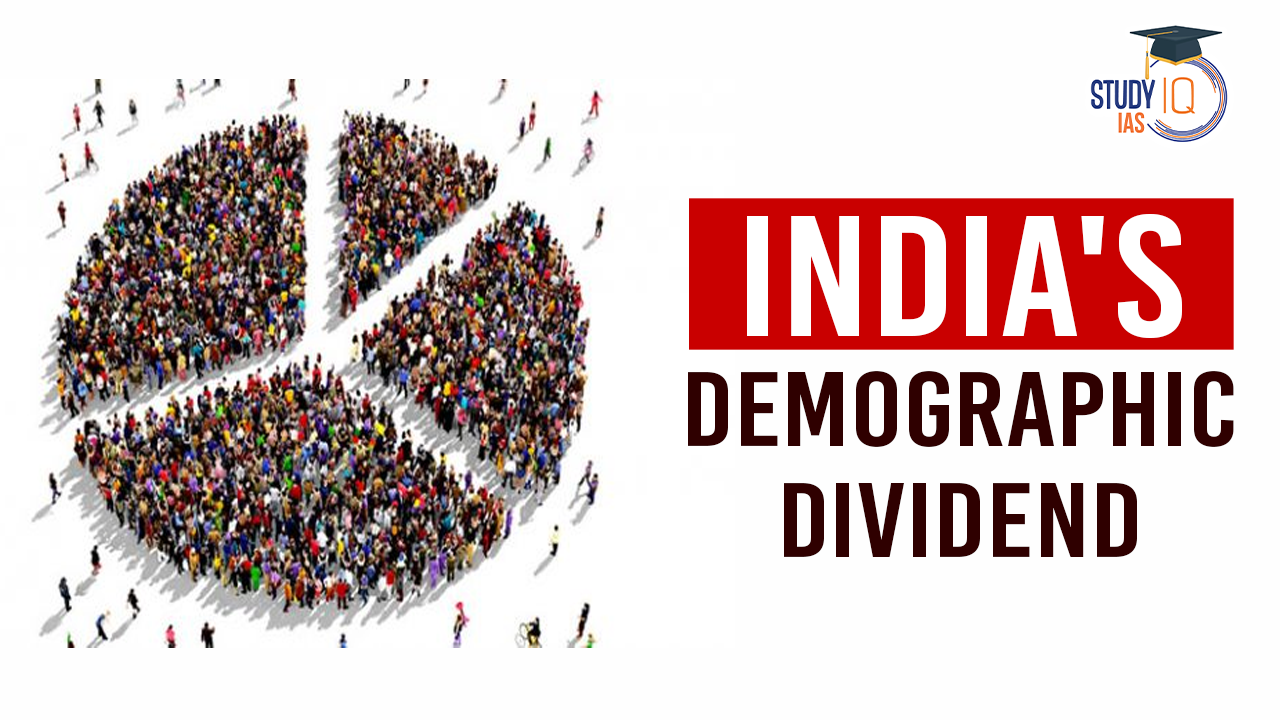Table of Contents
Context
- India’s demographic dividend offers immense potential for economic growth.
- However, realising this potential requires a strategic approach to address various challenges.
What is Meant by Demographic Dividend?
- Demographic dividend refers to the economic growth that occurs when a country’s population has a large proportion of working-age people (15 to 64 yrs) and a small proportion of dependent children and elderly people (14 and younger, and 65 and older).
- In India around 68% of the population falls into the working age, and 26% falls within the 10-24 age group.
- Also it is projected that India will have04b working age persons and India’s dependency ratio would be the lowest at 31.2% by 2030.
Importance of India’s Demographic Dividend
- Increased Labor Supply: A large young population provides a growing workforce.
- Enhanced Capital Formation: Lower dependency ratios lead to higher savings rates, fueling investment and economic growth.
- Boosted Economic Growth: Increased domestic demand and GDP per capita drive economic expansion.
- Innovation and Entrepreneurship: A young population is often more innovative and entrepreneurial.
- Improved Female Human Capital: Decreased fertility rates can lead to greater female participation in the workforce, enhancing human capital.
Challenges in Harnessing India’s Demographic Dividend
- Lack of Job Creation: India’s economy is not generating enough jobs to meet the demands of a rapidly growing population.
- Example: The Labour Force Participation Rate (LFPR) was only 55.2% in 2022 according to the International Labour Organization (ILO) report.
- Lack of Quality Education: The education system is not preparing young people for the job market.
- Example: Approximately 85% of Chinese children possess basic skills required for the international economy, compared to only 15% of Indian children.
- Skills Shortage: Only 4.4% of the workforce in the age cohort of 15-29 years is formally skilled, according to the Economic Survey 2023-24.
- Challenges for MSMEs: Micro, Small and Medium Enterprises (MSMEs) face barriers in scaling up due to compliance burdens from outdated labour laws.
- Technological Advancements: While AI/ML offers opportunities, it also poses a challenge in terms of job displacement.
- Example: AI/ML is estimated to grow by nearly nine times to become a $826.73 billion worldwide market by 2030, with a current gap between demand and supply of 51% in India)
- Employment in Unorganised and Non-Agricultural Sectors: About 19% of the workforce is engaged in the unorganised and non-agricultural sectors, which are highly fragmented and suffer from low productivity.
- Capital-Led Economic Growth: The Economic Survey for 2023-24 states that technological advancements have led to a declining capital-to-output ratio and an increasing capital-to-labour ratio, making capital-led economic growth not ideal for India.
Reforms Required
- Press Ahead with Ongoing Reforms Agenda: There is a need to press ahead with the ongoing reforms agenda to maintain, if not accelerate, India’s growth trajectory.
- Enhance Ease of Doing Business: The Centre has done much to enhance ease of doing business, but more needs to be done, especially in the context of production, which concerns the States.
- Implement New Labour Codes: The impasse over implementing the new labour codes approved by Parliament needs to be resolved, and one or two States with an evolved manufacturing ecosystem should take the lead.
- Boost to Manufacturing Sector: The Centre’s efforts to give a boost to the manufacturing sector are necessary, as it is untenable for 45% of the workforce to be employed in the agricultural sector, which accounts for only 18% of GDP.
- Focus on High-Growth Potential Sectors: It is important to address the aspirations of those engaged in unorganised and non-agricultural sectors by focusing on high-growth potential sectors such as toys, apparel, tourism, and logistics, which are also labour-intensive.
- Meaningful Public-Private Partnerships: Skilling requires meaningful public-private partnerships wherein industry plays an integral role in devising the curriculum and imparting ‘on the job training’.
- Review and Update the New Education Policy (NEP) 2020: The NEP 2020 needs to be reviewed periodically and updated to keep pace with the changing job market.


 UNESCO Global Network of Learning Cities...
UNESCO Global Network of Learning Cities...
 National Livestock Mission (NLM): Object...
National Livestock Mission (NLM): Object...

























